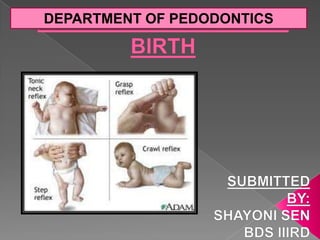
Reflexes present at birth
- 2. INTRODUCTION GENERAL BODY REFLEXES FACIAL REFLEX ORAL REFLEXES REFERENCE
- 3. A REFLEX is defined as an involuntary, or automatic, action that your body does in response to something, without even having to think about it. Types of reflexes present at birth: 1. General body reflexes 2. Facial reflexes 3. Oral reflexes
- 5. Any sudden movement of the neck initiates this reflex. A way of eliciting the reflex is to pull the baby half-way to sitting position from supine and suddenly let head fall back to a short distance. Reflex consists of rapid abduction and extension of arms with opening of hands.
- 6. Its nature gives an indication of the muscle tone. • The responses may be asymmetrical if muscle tone is unequal on two sides or there is a weakness of an arm or injury to humerous or clavicle This reflex disappears in 2-3 months.
- 7. STARTLE REFLEX • It is similar to moro reflex, but it is initiated by sudden noise or any other stimulus • In this, the elbows are flexed and the hands remain closed, there is less of embrace, outward and inward movement of arms.
- 8. • When the sole of the foot is WALKING/ pressed against couch, the STEPPING baby tries to walk. REFLEX • It persists as voluntary standing.
- 9. When the baby’s palm is stimulated, the hand closes. There is also a corresponding planter reflex. Both normally disappear by 24 months.
- 10. An exceptionally strong grasp reflex may be found in the spastic form of cerebral palsy and in kernicterus. It may be asymmetrical in hemiplegia and in cases of cerebral damage. It should have disappeared in 2-3 months and persistence may indicate the spastic form of cerebral palsy.
- 11. LIMB PLACEMENT REFLEX • When the front of the leg below the knee, or arm below the elbow is brought into contact with edge of the table, the child lifts the limb over the edge. BABINSKI’S REFLEX • Stroking of the lateral surface of the planter surface of the foot from the heel to the toe results in flexion of the toe.
- 12. When the baby is at rest and not crying, he lies at intervals with his head on one side, the arm extended to the same side, and often with a flexion of the contra lateral knee. This reflex normally disappears after 2 or 3 months, but may persist in spastic children.
- 13. It appears at about 6-9 months and persists thereafter. The reflex is elicited by holding the child in ventral suspension and suddenly lowering him to couch. The arms extend as defensive a defensive reaction. In children with cerebral palsy, the reflex may be absent or abnormal. It would be asymmetrical in spastic hemiplegia.
- 14. It is seen in vertical suspension, with the head, spine and legs extended. If the head is flexed, the hips, knees and the elbows also flex. It is normally present from 3 months and is difficult to elicit after 1 year. Absence of reflex occurs in hypotonia, hypertonia or
- 16. Stimulation of the face or nasal cavity with water or local irritants produce apnea in neonates. Breathing stops in expiration with laryngeal closure and infants exhibit bradycardia and lowering of cardiac output. Blood flow to skin, splanchic areas, muscles and kidney decreases, whereas the flow to the heart and brain is protected.
- 17. CORNEAL REFLEX • Consists of blinking when cornea is touched PUPIL REFLEX • Pupil reacts to light, but in preterm baby and some full term babies the duration of exposure to the light may have to be prolonged to elicit the reflex.
- 19. When the infant’s cheek contacts the mother’s breast, the baby’s mouth results in vigorous sucking movements resulting in baby rooting for milk. When the corner of mouth is touched, the lower lip is lowered, the tongue moves towards the point stimulated. When the finger slides away, the head turns to follow it.
- 20. Onset is 28 weeks IU Wellestablised by 32-34 weeks IU Disappears by 3-4 months
- 21. Onset~ 28 weeks iu Wellestablised~ 32-34 weeks iu Disappear~ around 12 months Elicited by~ introducing a finger into the mouth
- 22. Begins around 12 and half weeks IU life. Full swallowing and sucking is established by 32-36 weeks of IU life. Their absence in full-term baby would suggest a developmental defect.
- 23. INFANTILE SWALLOW •ACQUIRED CONGENITAL REFLEX •Until primary molars erupt, infant swallows with jaws separated and the tongue thrust forward using facial muscles. •This is non-conditional congenital reflex. •After eruption of posterior primary teeth, from18 months of age onwards, the child tends to swallow with teeth brought together by masticatory muscle action, without a tongue thrust.
- 24. Seen at 18 and half weeks of IU life. In buccal cavity and pharynx, the ectoderm/endoderm zone is towards the posterior third of tongue. Touching here elicits a gag reflex, a protective reflex.
- 25. It is a nonconditioned reflex which accounts for its lack of individual character and is of sporadic nature. Starts as early as 21-29 weeks IU life.
- 26. It is a conditioned reflex, learned initially by irregular and poorely coordinated, chewing movements. The proprioceptive responses of TMJ and PDL of erupting dentition establishes a stabilized chewing pattern, aligned to the individual dental intercuspation.
- 27. SHOBHA TONDON (FOR PEDIATRICS DENTISTRY) 2nd EDITION.